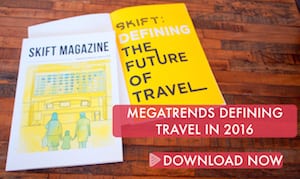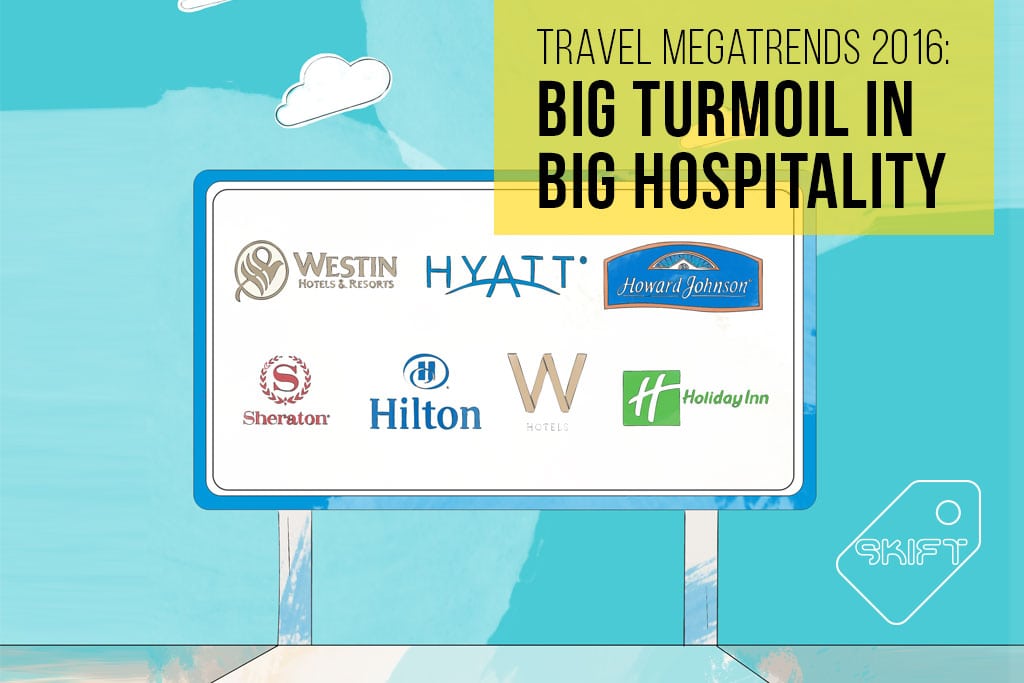Skift Take
Mergers, killing brands, globalization, and an ongoing fear of Airbnb and its ilk will keep 2016 interesting and prepare the industry for a bit of needed evolution.
Earlier this month we launched our annual package, Megatrends Defining Travel in 2016, where we identify the global trends in travel in 2016 and beyond.
Below is one of the megatrends in the magazine. This first megatrend is playing out in full force only a few weeks into 2016, with a big merger in the boutique hotel space announced last week, and news that Radisson’s parent Carlson Rezidor is on the block.
Big Turmoil in Big Hospitality
The global hospitality industry, comprised of the organized hotels sector, the organized vacation rentals sector and the former sharing economy sector, is driving all innovation in travel now. That much we said last year in the Skift Megatrends For 2015. That is still true.
 What is also true that at a time where everything about hospitality is being rethought, the industry that pioneered the chain experience and made global business travel consistent, stable and possible, is now in the midst of all kind of turmoil.
What is also true that at a time where everything about hospitality is being rethought, the industry that pioneered the chain experience and made global business travel consistent, stable and possible, is now in the midst of all kind of turmoil.
This is happening despite a record-level 2015 performance, and the big hospitality industry is left wondering what to do for a second act.
Last year was marked by a wholesale reinvention of hotels with heavy investments in design and technology and tremendous growth through lifestyle properties and soft brands. Hotels vied for first place in the race for relevance, fueled by OTA dominance, the sharing economy and consumer desire for local, authentic experiences.
To ride that momentum of innovation and to grow on top of record, hotels may turn to one strategy, mergers and acquisitions (M&A), which historically occur when the industry is on the uptick of its business cycle. That’s where where we find ourselves now.
Marriott seized the moment by buying Starwood for $12 billion. Weeks later Accor Hotels paid $2.9 billion for Fairmont, Raffles and Swissotel. Continued demand growth and record occupancy levels matched with modest supply growth will also foster 2016’s frenzy. The economic climate, healthy with flushed cash, is conducive for expansion.
Furthermore, brands today are asset-light — wherein they franchise and manage hotels rather than own them — freeing up cash to make companies cheaper to acquire and increasing market presence, attracting hotel owners keen for exposure.
M&A’s can also greatly shift the OTA landscape. Marriott’s deal created the world’s largest hotelier, rich in a portfolio of 30 brands. Such a powerhouse yields tremendous influence when negotiating with OTAs, as they themselves are huge entities. Brands can also better compete against disruptors like Airbnb by way of product differentiation, offering everything from budget to high-end resorts.
Growth is everything for hotels; it keeps shareholders happy, and it also expands their global footprint. Yet consolidation is a gamble. Acquiring brands, depending on whom they acquire and the integration process, could triumph. Smaller companies may benefit from parent company resources like CRM, marketing, sales, and reward programs.
Consumers may become spoiled with a vast network of choices and ample means to accrue loyalty. That’s the hope anyway, as the stage has been set for a flurry of M&A deals that will transform the industry.
Have a confidential tip for Skift? Get in touch
Tags: accor, marriott, marwood, megatrends, starwood
Photo credit: Big hospitality will continue its big M&A streak in 2016.
